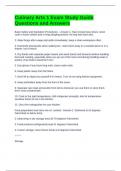-
1. Examen - 7th grade culinary arts final exam study guide questions and answers
-
2. Examen - Advanced culinary arts final study guide questions with latest update
-
3. Examen - Advanced culinary arts test exam questions and answers
-
4. Examen - Basic culinary skills final exam questions with latest update
-
5. Examen - Cula 101 introduction to culinary arts final study guide exam questions with latest u...
-
6. Examen - Culinary 2 final exam questions with verified answers
-
7. Examen - Culinary 2 final exam review questions with verified answers
-
8. Examen - Culinary arts 1 exam study guide questions and answers
-
9. Examen - Culinary arts 1 final exam questions and answers
-
10. Examen - Culinary arts 1- final exam review cmhs questions and answers
-
11. Examen - Culinary arts 1- final review exam questions and answers
-
12. Examen - Culinary arts 1a final review exam questions with correct answers
-
13. Examen - Culinary arts 2 final exam review questions and answers
-
14. Examen - Culinary arts 3 - midterm exam review questions with correct answers
-
15. Examen - Culinary arts 3 final exam questions and answers
-
16. Examen - Culinary arts and hospitality final exam review questions and answers
-
17. Examen - Culinary arts certification exam questions and answers
-
18. Examen - Culinary arts exam 2 questions with complete solutions
-
19. Examen - Culinary arts exam 3 questions with correct answers
-
20. Examen - Culinary arts exam questions and answers 2024
-
21. Examen - Culinary arts exam questions and answers latest update
-
22. Examen - Culinary arts exam questions with verified answers latest update
-
23. Examen - Culinary arts final exam q & a
-
24. Examen - Culinary arts final exam questions with complete solutions
-
25. Examen - Culinary arts final exam questions with latest update
-
26. Examen - Culinary arts final exam review questions with verified answers
-
27. Examen - Culinary arts final exam study guide exam questions with correct answers
-
28. Examen - Culinary arts final exam study guide questions and answers
-
29. Examen - Culinary arts food safety exam questions and answers
-
30. Examen - Culinary arts test 4 questions with correct answers
-
31. Examen - Culinary arts t2 exam questions and answers
-
32. Examen - Culinary arts state written test practice exam questions with correct answers
-
33. Examen - Culinary arts state test review exam questions with correct answers
-
34. Examen - Culinary arts skillsusa exam questions with correct answers
-
35. Examen - Culinary arts semester exam 1 questions and answers
-
36. Examen - Culinary arts safety test questions and answers
-
37. Examen - Culinary arts quiz exam questions and answers
-
38. Examen - Culinary arts mid term exam study guide questions with correct answers
-
39. Examen - Culinary arts ii practice test exam questions with correct answers
-
40. Examen - Culinary certification exam questions and answers
-
41. Examen - Culinary cte exam questions with latest update
-
42. Examen - Culinary end of program exam questions with latest update
-
43. Examen - Culinary exam practice test exam questions and answers
-
44. Examen - Culinary final exam study guide questions with complete solutions
-
45. Examen - Culinary final exam test with answers latest update
-
46. Examen - Culinary fundamentals culinary science exam questions and answers
-
47. Examen - Culinary fundamentals final exam questions and answers
-
48. Examen - Culinary level 2 final exam questions and answers
-
49. Examen - Culinary theory skills final exam review questions and answers
-
50. Examen - Final exam baking for culinary arts exam questions and answers
-
51. Examen - Final exam culinary arts i exam questions with verified answers
-
52. Examen - Final exam culinary arts questions with complete solutions
-
53. Examen - Foundations of restaurant management & culinary arts 2nd edition level 2 industry fin...
-
54. Examen - Intro culinary arts final exam q & a
-
55. Examen - Intro culinary arts final exam questions with verified answers
-
56. Examen - Intro to culinary arts final exam review questions with complete solutions
-
57. Examen - Intro to culinary arts final exam- semester 1 questions and answers
-
58. Examen - Introduction to culinary arts study guide exam questions and answers
-
59. Examen - Multiple choice culinary arts final exam questions and answers
-
60. Examen - Nc culinary arts & nutrition 1 final exam questions and answers
-
61. Examen - Overall study aafcs culinary arts industry test exam questions and answers
-
Mostrar más




